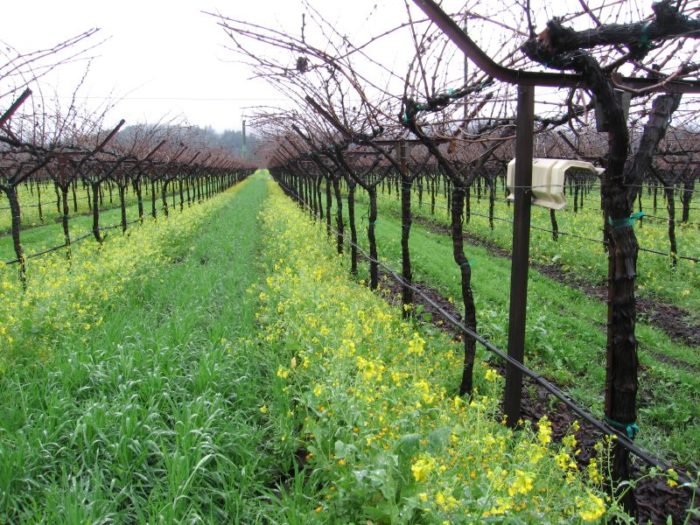
The Environmental Quality Incentives Program (EQIP) awarded more than $1.2 billion annually in financial assistance (FA) to American farmers and ranchers in fiscal years (FY) 2019 and 2020. These funds are provided through the US Department of Agriculture (USDA)’s Natural Resources Conservation Service (NRCS) and offer financial cost-share and technical assistance to help growers implement conservation practices on working agricultural lands. Over its twenty-five year history, EQIP has significantly expanded its reach and capacity. Despite its growth, however, EQIP funds are still insufficient to support even half of applicant projects. Moreover, substantial EQIP funds continue to be directed toward confined animal feeding operations (CAFOs) rather than conservation projects with substantial environmental benefits to soils, water, and climate.
In this blog post, we analyze how EQIP financial assistance was utilized in FY 2019 and FY 2020 through the EQIP general pool. This post does not include an analysis of EQIP funding for technical assistance, nor does it assess the investments made with EQIP funds through the Regional Conservation Partnership Program.
EQIP: The Basics
EQIP participants can select from a wide variety of practices that improve conservation and environmental quality on their farms, including structural, vegetative and management practices. Through EQIP, NRCS may reimburse up to 75 percent of the costs for these practices, and up to 90 percent of the costs for beginning, socially disadvantaged, limited resource and veteran farmers and ranchers. This group of farmers and ranchers are also eligible for an advance payment of up to 50 percent for costs associated with planning, design, materials, equipment, installation, labor, management, maintenance, or training.
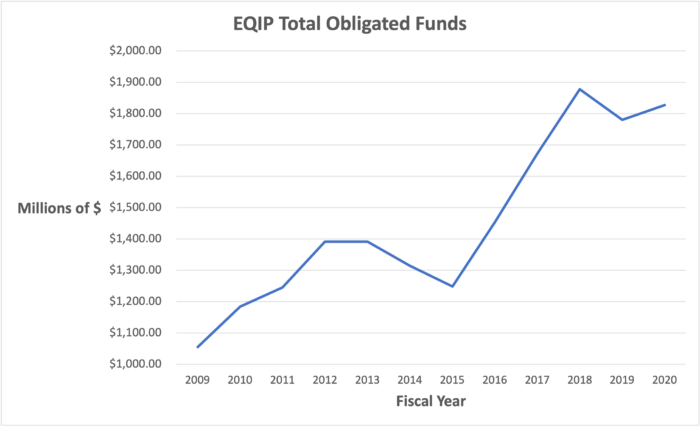
Despite the general upward trend in obligated funding since 2009, farmer and rancher demand for EQIP has consistently outstripped available funding. In 2019, among all eligible applicants across the US, only 28 percent actually received contracts. In 2020, that number was just under 27%. Among approved contracts there were considerable disparities in acceptance rates between states; however, no state came close to approving all eligible applicants.
State Trends in FY 2019 and FY 2020
In 2019, Rhode Island had the highest rate of contract approval at 68%, and Arkansas had the lowest rate at 13%. In 2020, Alaska had the highest rate of contract approval at 62%, and Arkansas had the lowest rate at 14%. There was also considerable variance in the total amount of obligated funds across each state. In both 2019 and 2020, Texas and California were the top recipients of funds by far, with Texas ahead in 2019 and California in 2020.
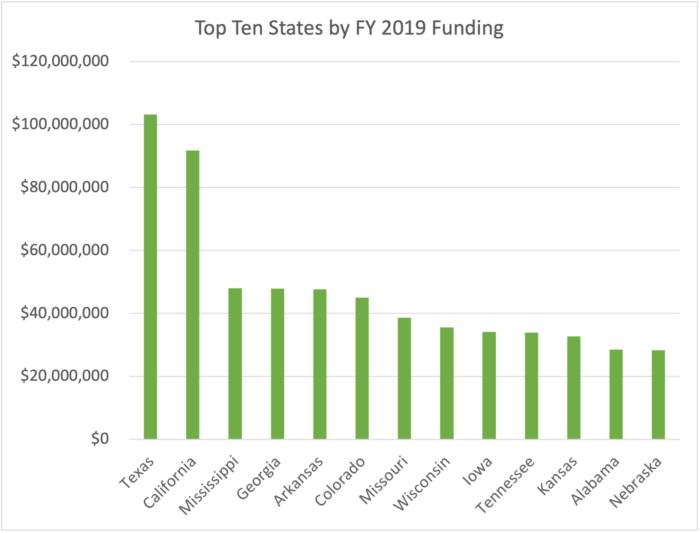
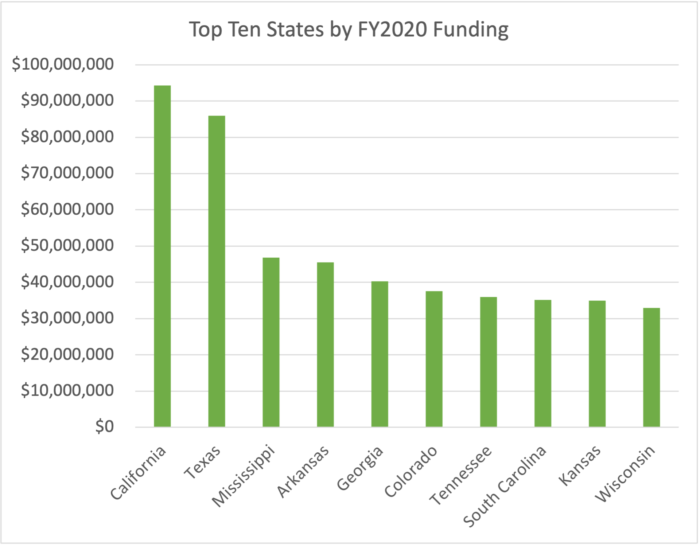
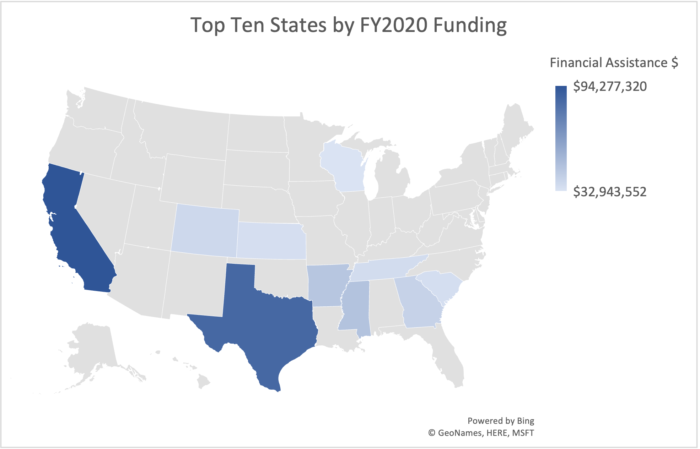
The considerable variance in acceptance rates across the country suggests not only differing levels of demand, but also differences in state ranking criteria and varying levels of outreach and promotion by state NRCS offices and partner groups.
Funding for Cover Crops Declines
Of all available conservation practices eligible for EQIP funding in FY 2019 and FY 2020, the largest amount was obligated for cover crops. Cover crops, which include grasses, legumes, and other seasonable vegetative cover, help producers to reduce erosion, improve soil health, suppress weed pressures, and reduce water quality degradation.
NRCS obligated more than $124 million in EQIP funding for cover cropping in FY 2019, and just over $84 million in 2020. Both represent declines from the 2018 funding level of $132 million. This funding provided support for more than 3.5 million acres of cover crops in FY 2019, and 2.4 million acres FY 2020. The graphs and maps below illustrate the top five states that received cover crop funding, as well as those that planted the most acres of cover crops through EQIP in FY 2019 and FY 2020.
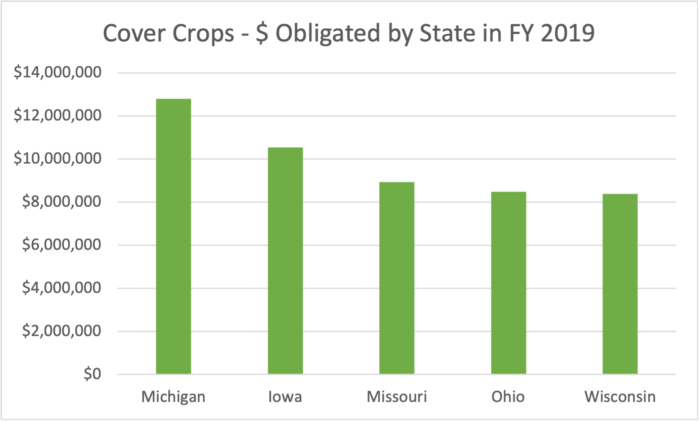
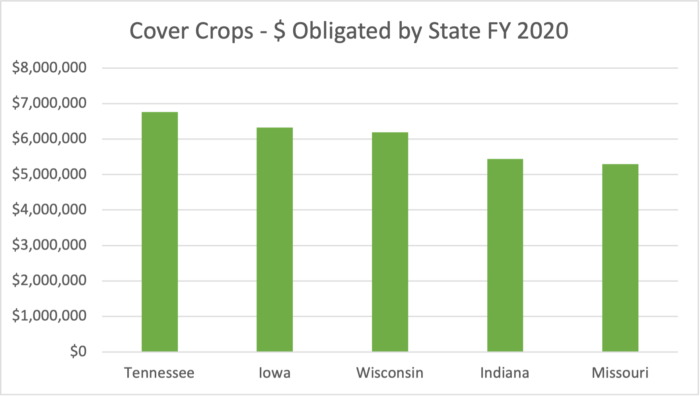
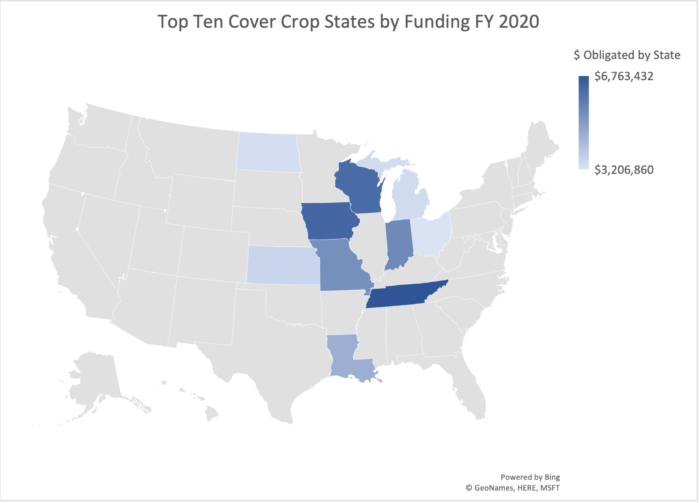
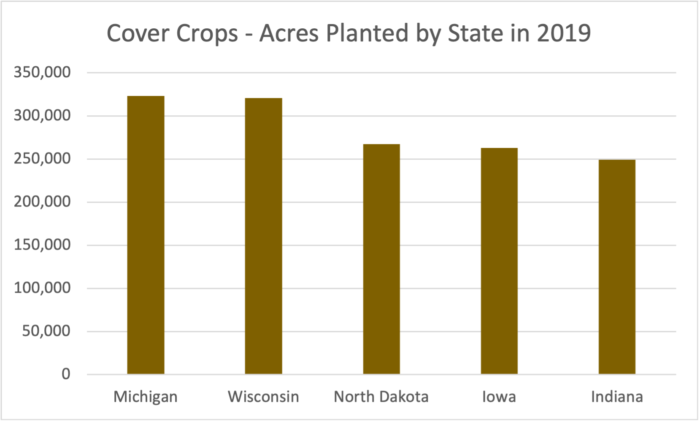
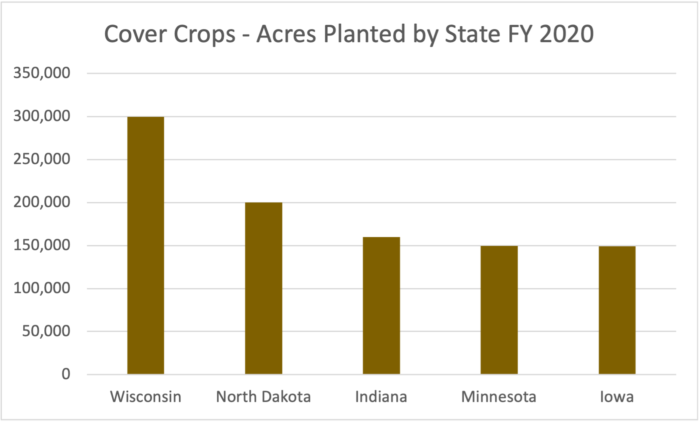
Other Sustainable Management Practices
In addition to cover crops, EQIP funding is available for a wide range of other sustainable management practices (both vegetative and land management practices). These practices include but are not limited to: conservation crop rotation, riparian forest buffer installation, terraces, and prescribed grazing. Overall, NRCS allotted over $350 million for these sustainable practices in both FY 2019 and FY 2020. Cover crops received the most funding at $126 million in FY 2019 and $84 million in FY 2020. The next highest spending was for forest stand improvement ($39 million in FY 2019; $41 million in FY 2020) and pasture and hayland planting ($32 million in both FY 2019 and 2020).
For sustainable livestock producers, prescribed grazing is a particularly important practice because it confers many of the same benefits to livestock producers as cover crops do for crop growers. EQIP supports livestock producers with financial and technical assistance that helps them manage the harvest of vegetation with the grazing and/or browsing of animals. Prescribed grazing enables producers to improve species diversity and plant vigor, mitigate erosion, support water quality, and improve the quality of food available for livestock. The chart below highlights the top five states by acres of prescribed grazing supported through EQIP in FY 2019 and FY 2020.
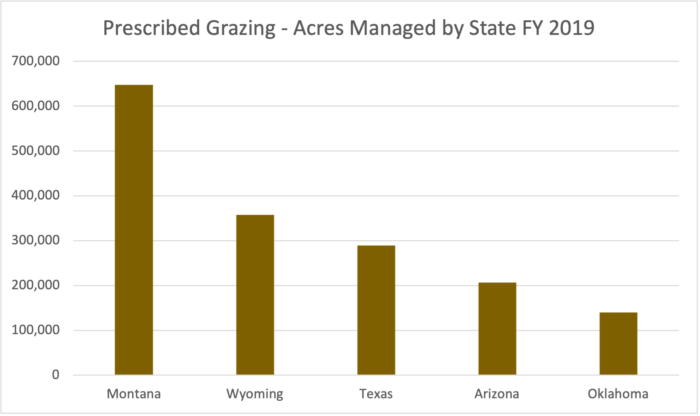
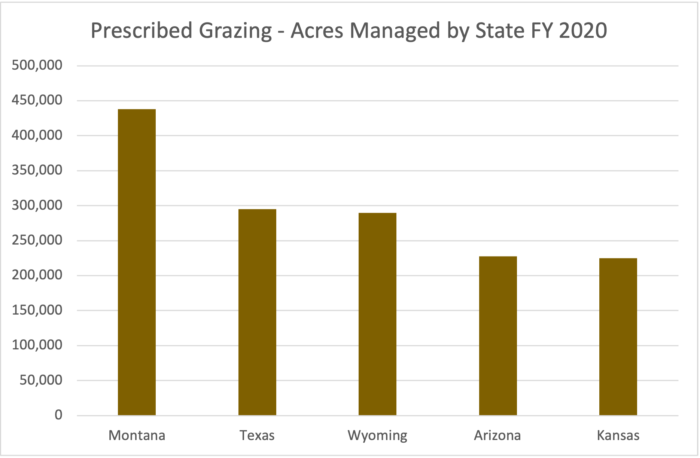
Funding levels for prescribed grazing fell from FY 2018 to FY 2019 (from $18 million to $15 million), but rose again to $18 million in FY 2020. The number of acres under this grazing practice varied, with nearly 2.7 million acres in FY 2018, 2.8 million acres in FY 2019, and more than 2.5 million acres in FY 2020. This acreage remains low relative to the period around 2010, when acreages under prescribed grazing were as high as 6.35 million acres (in FY 2008). This trend is worrisome, as pasture-based livestock production is an integral piece of sustainable agriculture systems. The National Sustainable Agriculture Coalition (NSAC) has long advocated that NRCS direct a larger percentage of EQIP dollars toward small and mid-sized family farms seeking to implement or maintain prescribed grazing and other sustainable livestock practices, and significantly reduce the use of EQIP funds for confined animal feeding operations.
Confined Animal Feeding Operations
Unfortunately, while the number of acres enrolled in sustainable grazing practices has declined, NRCS has continued to dedicate large amounts of funding to help CAFOs pay for structural practices such as waste lagoons, animal mortality facilities, and waste treatment facilities.
CAFOs have negative impacts on water and air quality and human health. As an environmental program, EQIP should not be underwriting these operations,particularly in regions where they significantly contribute to water and air quality impairments.
In FY 2019, almost 10 percent ($121 million) of EQIP funds were allocated toward CAFO operations. Top supported practices included: waste storage facilities ($49,503,473); waste facility covers ($39,692,457); animal mortality facilities ($9,716,499); and manure transfer ($7,562,840).
In FY 2020, more than 11 percent ($134 million) of EQIP funds were allocated toward CAFO operations. Top supported practices included: waste storage facilities ($52,284,253) waste facility covers ($50,302,069); animal mortality facilities ($11,937,300); and manure transfer ($7,085,847).
With such a significant portion of EQIP funding going toward the support of CAFO practices, less support is available for small and mid-sized farms trying to implement sustainable management practices on their lands. We continue to urge NRCS to prioritize applications for livestock practices that enhance or help transition producers toward sustainable livestock management systems, rather than supporting the expansion of CAFOs.
Irrigation Practices
Similar to prior years, irrigation practices (e.g., pipelines, sprinkler systems, canal construction, and land leveling) once again secured a significant portion of EQIP funds in FY 2019 and FY 2020. NRCS obligated $194 million towards irrigation funding in FY 2019 – over 15 percent of all EQIP funding that year. It obligated $166 million towards irrigation funding in FY 2020 – nearly 14 percent of all EQIP funding.
While irrigation is crucial to many farming systems, there are certain irrigation practices (funded by EQIP) that overuse water and ultimately reduce in-stream flows. We have serious concerns about the significant portion of EQIP funds that support irrigation practices in circumstances when water savings are used to expand irrigated crop production. As such, we continue to urge NRCS to explore options for ensuring that EQIP funding does not incentivize the over-consumption of water resources.
EQIP and Equity
EQIP grants are one means through which so-called “socially disadvantaged” farmers and ranchers receive the assistance they need to introduce more sustainable methods on their operations.
NRCS classifies producers as “socially disadvantaged” (SDA) if they are in the following groups:
- American Indians or Alaska Natives
- Asians
- Blacks or African Americans
- Native Hawaiians or other Pacific Islanders
- Hispanics
Information gathered by USDA on race and ethnicity is inconsistent and therefore it is often difficult to glean a clear message from any data related to race and ethnicity. However, based on the information publicly available in the 2020 EQIP data and the 2017 Census of Agriculture, we can at least identify states offering the most EQIP contracts and the most EQIP financial assistance to farmers and ranchers classed as SDA The top ten states for number of EQIP contracts to SDA farmers, and top ten states for total EQIP financial assistance to SDA farmers, are laid out below.
Top Ten States/Territories in # of EQIP Contracts to SDA farmers and ranchers
| State | # of contracts to socially disadvantaged farmers and ranchers |
| California | 447 |
| Texas | 337 |
| Puerto Rico | 318 |
| Georgia | 308 |
| Mississippi | 300 |
| Alabama | 248 |
| Oklahoma | 197 |
| Arkansas | 162 |
| South Carolina | 151 |
| New Mexico | 102 |
Top Ten States/Territories in EQIP Financial Assistance to SDA farmers and ranchers
| State | Financial assistance to socially disadvantaged farmers and ranchers |
| California | $22,751,859 |
| Georgia | $11,018,311 |
| Texas | $9,781,928 |
| Puerto Rico | $7,473,852 |
| Alaska | $7,260,207 |
| New Mexico | $6,903,400 |
| Oklahoma | $6,052,301 |
| Mississippi | $5,739,771 |
| Montana | $4,687,845 |
| Arkansas | $4,582,327 |
When it comes to determining whether the share of EQIP support going to “socially disadvantaged” producers is appropriate, the question becomes further complicated by past misrepresentations and inaccuracies of USDA Census Data. With allegations of past discrimination still unresolved and a continued lack of clarity in the accuracy of the Census of Agriculture numbers, it is hard to know how best to determine whether USDA is adequately meeting the needs of “socially disadvantaged” (SDA) farmers. However, with the available data, we can at least check the Census of Agriculture numbers against percentages of EQIP contracts going to SDA farmers and ranchers and against the percentage of financial assistance going to the same groups. The table below lays out the numbers for the 50 states and Puerto Rico. Numbers for principal producers in the Pacific Basin did not appear to be part of the National Agricultural Statistics Service measures.
Although numbers for most of the states look fairly representative, with percentages of contracts and total funding to SDA producers exceeding the percentages of principal producers in that geographic area, a few states stand out even in this regard. In Arizona, for example, 58% of producers are classified by race as SDA. Yet only 14.5% of EQIP funding and 14% of contracts went to SDA principal producers in Arizona. Similarly, in Texas, 10% of principal producers are classified as SDA by ethnicity. However, only 4% of EQIP contracts went to SDA producers in Texas, and only 11.4% of funding, even though additional principal producers qualify as SDA based on race. Arkansas is another notable state in this regard, with 19% of producers qualifying as SDA based ethnicity, but only 13% of contracts and 10% of funding to all SDA principal producers. With states with smaller percentages of SDA farmers and ranchers, the smaller numbers make it harder to distinguish differences, but Utah, Nebraska, and Massachusetts all appear to potentially have a higher percentage of SDA principal producers than the proportion one would expect to receive EQIP grants.
| State | % of Financial Assistance to socially disadvantaged (SDA) producers | % of all principal producers that are NRCS SDA by race | % of all principal producers that are NRCS SDA by ethnicity (i.e. Hispanic/Latino/Spanish) | % of all contracts that went to SDA producers |
| Pacific Basin | 100.00% | Not available | Not available | 100% |
| Puerto Rico | 87.94% | 7% | 99% | 88% |
| Alaska | 79.09% | 4% | 2% | 38% |
| Hawaii | 43.92% | 36% | 6% | 45% |
| Delaware | 30.02% | 2% | 1% | 11% |
| New Mexico | 28.16% | 21% | 31% | 35% |
| Georgia | 27.37% | 5% | 1% | 22% |
| Oklahoma | 24.72% | 11% | 2% | 22% |
| California | 24.13% | 7% | 1% | 30% |
| Alabama | 16.46% | 8% | 1% | 18% |
| Florida | 16.37% | 6% | 9% | 14% |
| Montana | 14.52% | 4% | 1% | 12% |
| Arizona | 14.48% | 58% | 5% | 14% |
| Nevada | 14.37% | 6% | 5% | 18% |
| South Dakota | 13.58% | 2% | 1% | 13% |
| Louisiana | 12.29% | 8% | 2% | 13% |
| Mississippi | 12.26% | 14% | 1% | 16% |
| Texas | 11.38% | 4% | 10% | 4% |
| Connecticut | 10.92% | 1% | 1% | 9% |
| Virginia | 10.83% | 3% | 1% | 10% |
| Arkansas | 10.07% | 5% | 19% | 13% |
| Washington | 10.04% | 2% | 4% | 9% |
| Tennessee | 9.98% | 2% | 1% | 7% |
| Colorado | 9.44% | 2% | 6% | 9% |
| West Virginia | 9.39% | 2% | 1% | 4% |
| North Carolina | 8.46% | 4% | 1% | 13% |
| Maryland | 8.23% | 3% | 1% | 7% |
| South Carolina | 7.28% | 8% | 1% | 15% |
| Michigan | 6.70% | 1% | 1% | 4% |
| Oregon | 6.62% | 2% | 3% | 4% |
| New Jersey | 6.39% | 2% | 3% | 9% |
| Maine | 5.66% | 2% | 1% | 3% |
| Utah | 4.73% | 4% | 2% | 4% |
| Idaho | 4.56% | 1% | 3% | 3% |
| Missouri | 3.55% | 1% | 1% | 4% |
| Wyoming | 3.54% | 1% | 2% | 7% |
| Wisconsin | 3.49% | 1% | 1% | 3% |
| North Dakota | 2.64% | 1% | 1% | 5% |
| Minnesota | 2.50% | 1% | 1% | 3% |
| Kentucky | 2.34% | 1% | 1% | 4% |
| Ohio | 2.11% | 0% | 1% | 2% |
| New York | 1.77% | 1% | 1% | 4% |
| Rhode Island | 1.40% | 2% | 1% | 3% |
| Kansas | 1.37% | 1% | 1% | 2% |
| Vermont | 1.14% | 1% | 1% | 3% |
| Massachusetts | 0.98% | 2% | 2% | 2% |
| Pennsylvania | 0.93% | 0% | 1% | 3% |
| Nebraska | 0.70% | 3% | 1% | 1% |
| Iowa | 0.62% | 0% | 1% | 1% |
| Indiana | 0.60% | 0% | 1% | 1% |
| Illinois | 0.30% | 0% | 1% | 1% |
USDA appears to be doing the hard work of rectifying past wrongs and building a better basis for future support of SDA producers. NSAC will continue to track whether or not conservation assistance to SDA farmers and ranchers meets producers’ needs.

